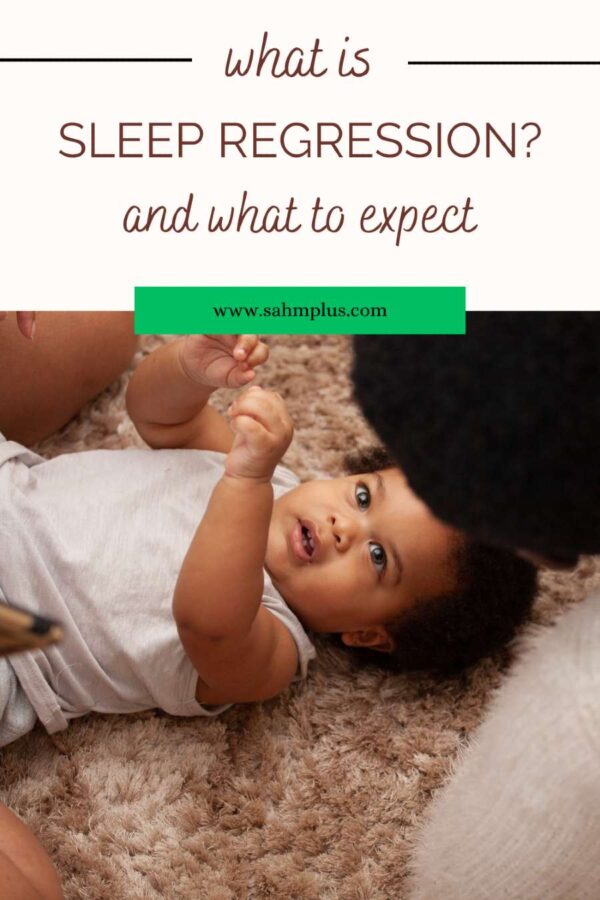So, you and your baby have gotten into a consistent bedtime routine, but suddenly your baby’s sleep has gotten out of whack. It could be a sleep regression. But what is a baby sleep regression? We’ll talk about what this is, what to expect and how to get back on track.
Becoming a parent is an exciting and fulfilling experience, but it’s also a challenging one. One of the biggest challenges new parents face is helping their baby establish healthy sleep habits. Just when you think you’ve got a routine down, your baby may start waking up more frequently or have trouble falling asleep. This can be frustrating and exhausting for both you and your little one. As someone who has experienced this firsthand with my two children, I understand how tough sleep regression can be. In this article, we’ll explore what sleep regression is, the signs to look for, the ages at which babies typically experience it, what triggers it, and most importantly, how to fix it.

What is Baby Sleep Regression?
Simply put, a sleep regression is a period when a baby’s sleep patterns change. This can mean that your baby may wake up more frequently during the night, take shorter naps, or have a harder time falling asleep. Sleep regressions typically last anywhere from two to six weeks, but it can vary from baby to baby. The most common times for sleep regressions to occur are at four months, eight months, and twelve months.
Signs of Sleep Regression
One of the most obvious signs of sleep regression is a change in your baby’s sleep patterns. If your little one was previously sleeping through the night but is now waking up frequently, it’s likely that they’re experiencing a sleep regression. Other signs can include:
- Increased fussiness or irritability
- Difficulty falling asleep
- Shorter naps
- Changes in appetite
It’s important to remember that every baby is different, and some may experience sleep regressions differently than others. Keep an eye out for any changes in your baby’s behavior that may signal a sleep regression.
Ages Babies Experience Sleep Regressions
Sleep regressions can occur at any age, but they are most common at four months, eight months, and twelve months. Here’s what you can expect during each of these periods:
- Four-month sleep regression: This is often the first sleep regression that parents experience. During this time, your baby may start waking up more frequently during the night, and naps may become shorter. This regression is often caused by developmental changes, such as increased awareness of the world around them.
- Eight-month sleep regression: This sleep regression is often caused by teething or separation anxiety. Your baby may wake up more frequently during the night and have a harder time falling asleep.
- Twelve-month sleep regression: Around their first birthday, your baby may experience another sleep regression. This can be caused by the transition from two naps a day to one nap or by developmental changes, such as walking.
It’s important to remember that every baby is different, and some may experience sleep regressions at different times or not at all. If you’re unsure whether your little one is experiencing a sleep regression, talk to your pediatrician.
What Triggers Sleep Regression?
There are many factors that can trigger sleep regression in babies. Here are some of the most common:
- Developmental changes: As your baby grows and develops, their sleep patterns may change. This can include increased awareness of their surroundings or new skills, such as rolling over or crawling.
- Teething: Teething can be a painful process for babies, and it can disrupt their sleep patterns.
- Illness: If your baby is sick or has a cold, they may have a harder time sleeping.
- Changes in routine: If there have been any recent changes in your baby’s routine, such as starting daycare or a new caregiver, it can disrupt their sleep patterns.
- Separation anxiety: As your baby gets older, they may experience separation anxiety, which can make it harder for them to fall asleep or stay asleep.
How to Fix Sleep Regression in Babies
While sleep regressions can be frustrating for parents, there are things you can do to help your little one get back to their regular sleep routine. Here are some tips to fix sleep regression in babies:
- Stick to a routine: Babies thrive on routine, so try to keep their schedule as consistent as possible. This means keeping the same bedtime, wake-up time, and nap times every day.
- Create a calming bedtime routine: Establishing a calming bedtime routine can help signal to your baby that it’s time to sleep. This can include a bath, a story, or some quiet time before bed.
- Offer comfort: If your baby is waking up more frequently during the night, offer them comfort, such as a gentle pat on the back or a soothing voice. Avoid picking them up or feeding them unless they’re genuinely hungry.
- Be patient: Sleep regressions can be tough but remember that they’re temporary. It may take a few weeks, but your baby will eventually go back to their regular sleep routine.
- Don’t create bad habits: It can be tempting to create bad habits, such as feeding your baby every time they wake up, but this can make it harder for them to sleep through the night. Stick to your routine, and your baby will eventually learn to self-soothe and fall back asleep on their own.
- Consider sleep training: If your baby is having a hard time falling asleep or staying asleep, sleep training may be an option. This involves gradually teaching your baby to fall asleep on their own without any external soothing.
Remember that every baby is different, and what works for one may not work for another. If you’re struggling with sleep regression, talk to your pediatrician or a sleep consultant for personalized advice.
Sleep regressions are a normal part of a baby’s development, and it’s important for parents to be patient and understanding during this time. Recognizing the signs of sleep regression and taking steps to help your little one get back to their regular sleep routine can help make the process easier for everyone involved. Remember that every baby is different, and what works for one may not work for another. With a little patience and perseverance, your baby will eventually go back to their regular sleep routine.
Continue reading our guide to sleep regressions:
- Sleep Regression: What is It and What to Expect (this post)
- 4 Signs of Sleep Regression to Watch For
- Sleep Regression Ages
- Why Does Sleep Regression Happen?
- How to Deal with Sleep Regression


1 comment
It is so wonderful and soft, and the brown sugar gives it such a richness of flavour. It is really wonderful!
Comments are closed.